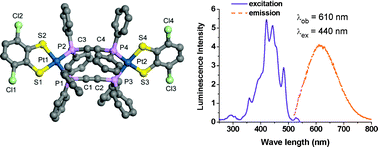A series of heteroleptic binuclear Pd(II) and Pt(II) complexes, [M(bdts)]2(μ-dppa)2 (M = Pd (3) and Pt (4); dppa = 1,2-bis(diphenylphosphino)acetylene = Ph2PC![[triple bond, length as m-dash]](https://www.rsc.org/images/entities/char_e002.gif) CPPh2; bdts = 1,2-benzenedithiolate (bdt: a), 3,4-toluenedithiolate (tdt: b) and 1,4-dichloro-2,3-benzenedithiolate (Cl2bdt: c), containing two square-planar MP2S2 cores were prepared using (MCl2)2(μ-dppa)2 (M = Pd (1) and Pt (2)) and the corresponding 1,2-benzenedithiols, and characterized by spectroscopic methods including FT-IR, Raman, UV-vis, MALDI-TOF-MS, 31P{1H} and/or 195Pt{1H} NMR spectroscopy. X-Ray crystal structure analyses for complexes 3 and 4 revealed that C1C2C4C3 is twisted in two ways with a torsion angle of 21.6–30.7° for 3a, 3b, 4a and 4b and about 42° for 3c and 4c, and that their crystals are racemic mixtures. Due to the more electronegative chloride atoms in the ligand, complexes 3c and 4c show higher ν(M–S) vibrational frequencies in their Raman spectra, smaller spin–spin coupling constants (JPt–P) in their 195Pt{31P} NMR spectra and higher anodic potentials (Epa) in their cyclic voltammograms than complexes 3a, 3b, 4a and 4b. Moreover, only complex 4c containing the chlorinated ligand and Pt(II) ion exhibits luminescence (λob = 610 nm and λex = 440 nm) in the solid state at 298 K. This emissive transition can be assigned as the d–π*dithiolate metal-to-ligand charge transfer (MLCT) and the feasibility of this spin-forbidden transition is ascribed to the effective spin–orbit coupling of ligand c containing heavy chloride atoms and the large spin–orbit coupling in Pt(II).
CPPh2; bdts = 1,2-benzenedithiolate (bdt: a), 3,4-toluenedithiolate (tdt: b) and 1,4-dichloro-2,3-benzenedithiolate (Cl2bdt: c), containing two square-planar MP2S2 cores were prepared using (MCl2)2(μ-dppa)2 (M = Pd (1) and Pt (2)) and the corresponding 1,2-benzenedithiols, and characterized by spectroscopic methods including FT-IR, Raman, UV-vis, MALDI-TOF-MS, 31P{1H} and/or 195Pt{1H} NMR spectroscopy. X-Ray crystal structure analyses for complexes 3 and 4 revealed that C1C2C4C3 is twisted in two ways with a torsion angle of 21.6–30.7° for 3a, 3b, 4a and 4b and about 42° for 3c and 4c, and that their crystals are racemic mixtures. Due to the more electronegative chloride atoms in the ligand, complexes 3c and 4c show higher ν(M–S) vibrational frequencies in their Raman spectra, smaller spin–spin coupling constants (JPt–P) in their 195Pt{31P} NMR spectra and higher anodic potentials (Epa) in their cyclic voltammograms than complexes 3a, 3b, 4a and 4b. Moreover, only complex 4c containing the chlorinated ligand and Pt(II) ion exhibits luminescence (λob = 610 nm and λex = 440 nm) in the solid state at 298 K. This emissive transition can be assigned as the d–π*dithiolate metal-to-ligand charge transfer (MLCT) and the feasibility of this spin-forbidden transition is ascribed to the effective spin–orbit coupling of ligand c containing heavy chloride atoms and the large spin–orbit coupling in Pt(II).
![[triple bond, length as m-dash]](https://www.rsc.org/images/entities/char_e002.gif) CPPh2; bdts = 1,2-benzenedithiolate (bdt: a), 3,4-toluenedithiolate (tdt: b) and 1,4-dichloro-2,3-benzenedithiolate (Cl2bdt: c), containing two square-planar MP2S2 cores were prepared using (MCl2)2(μ-dppa)2 (M = Pd (1) and Pt (2)) and the corresponding 1,2-benzenedithiols, and characterized by spectroscopic methods including
CPPh2; bdts = 1,2-benzenedithiolate (bdt: a), 3,4-toluenedithiolate (tdt: b) and 1,4-dichloro-2,3-benzenedithiolate (Cl2bdt: c), containing two square-planar MP2S2 cores were prepared using (MCl2)2(μ-dppa)2 (M = Pd (1) and Pt (2)) and the corresponding 1,2-benzenedithiols, and characterized by spectroscopic methods including 

 Please wait while we load your content...
Please wait while we load your content...